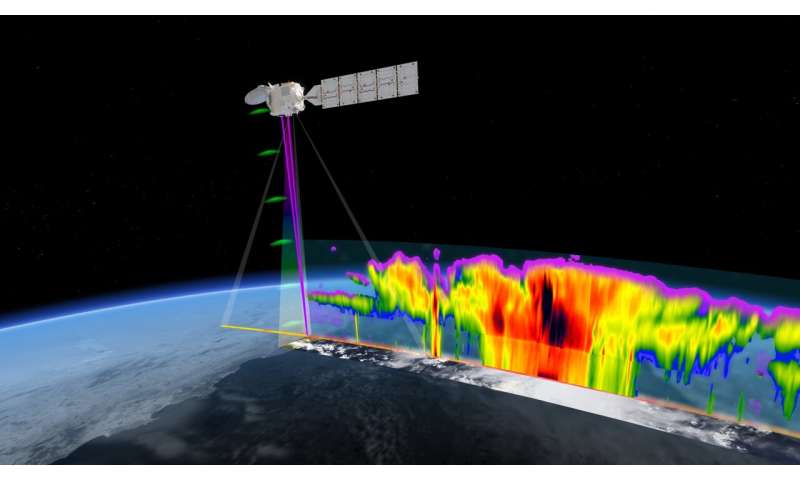Joining forces on the complexities of clouds and aerosols

In just a few months, ESA's EarthCARE satellite will be lofted into orbit to fill in a piece of the complex climate puzzle—that piece being how clouds and aerosols, small particles such as dust suspended in the air, affect Earth's energy balance.
With the climate crisis upon us, this information is needed more urgently than ever—so much so, that the science of clouds and aerosols has been prioritized by the European Commission and ESA as part of their new Earth System Science Initiative.
Joining forces, the EC and ESA recently launched the Earth System Science Initiative to provide a coordinated response to critical environmental challenges and related scientific questions.
The EC's Research and Innovation Department and ESA's Earth Observation Programs Directorate are aligning a set of selected scientific activities under their respective Horizon Europe and FutureEO programs.
The aim is to match objectives, content and planning to jointly advance Earth system science and its contribution to responding to global challenges faced by society at large.
The initiative, which covers a range of Earth-science topics, will improve Earth system models and, importantly, deliver science-based information and tools to help European authorities and citizens deal with environmental threats caused by climate change.
John Bell, Director of Healthy Planet in the EC's Directorate-General for Research & Innovation, said, "The EC–ESA Earth System Science Initiative contributes to our vision of a sustainable and resilient Europe.
"Fostering the collaboration between projects funded by ESA's FutureEO and our Horizon Europe programs not only boosts the scientific output of the projects, but helps us deliver on the EU policy goals expressed in the European Green Deal, including climate change adaptation."
One priority area focuses on clouds and aerosols and their role in the climate system—which is also tied to preparing for ESA's upcoming EarthCARE mission.
Simonetta Cheli, ESA's Director of Earth Observation Programs, noted, "One of the new EC–ESA collaborative research actions focuses on the interactions between clouds, aerosols, incoming solar energy and energy emitted by our planet, which play a major role in our climate system.
"I look forward to seeing the outcomes, especially in light of our EarthCARE satellite which will be launched in a few months."
EarthCARE carries a set of four state-of-the-art instruments that work together to provide a holistic view of complex interplay between clouds, aerosols and radiation to yield new insight into the radiation balance against the backdrop of the climate crisis.
The actual temperature at the surface of Earth is the result of a delicate balance between incoming radiation from the sun, which heats it, and outgoing thermal radiation, which cools.
Although it is known that clouds play an extremely important role in this balance, there still remains significant uncertainty about their role in the current and future climate system, and subsequently also on the exact impact that further greenhouse-gas emissions will have.
Aerosols influence the life cycle of clouds and so contribute indirectly to their radiative effect. Albeit to a lesser extent, aerosols also reflect incoming solar energy back out to space and can trap outgoing infrared energy.
Overall, clouds and aerosols currently have a net cooling effect, which is expected to decline in the future.
With three new science projects funded, the EC–ESA collaboration brings together a group of outstanding scientists, who will link observations from the ground and from satellites with models and process studies.
The group will make the best out of EarthCARE to advance climate models and to advise decision makers on the effectiveness of climate and air-quality policies.
Vassilis Amiridis, Research Director at the National Observatory of Athens and key scientist for ESA's AIRSENSE project, said, "Through improved representations of aerosols, clouds and their interactions with radiation, AIRSENSE will exploit the revolutionary EarthCARE mission to help unlock the prediction capability of Earth-system models."
Jennie Thomas, Project Coordinator at the French National Center for Scientific Research and also coordinator for the EC-funded CERTAINTY project, added, "We combine modeling and observation expertise to understand cloud–aerosol processes and their links to global climate and society. We have a world-leading team of European experts to address this urgent science need."
Athanasios Nenes, Professor at the Swiss Federal Institute of Technology Lausanne and and Ulas Im, Senior Scientist at Aarhus University in Denmark, both of whom are coordinators of the EC CleanCloud project, noted, "There are large uncertainties associated with our current understanding of the Earth system and its response to human actions. We need to close these knowledge gaps to be able to predict to what extent the Paris Agreement can be met and what changes lie ahead."
Director John Bell concluded, "The collaboration on aerosol and clouds will improve climate predictions and provide support to our regions to adapt to warming temperatures, thus also help achieve the goals on adaptation to climate change."
Provided by European Space Agency